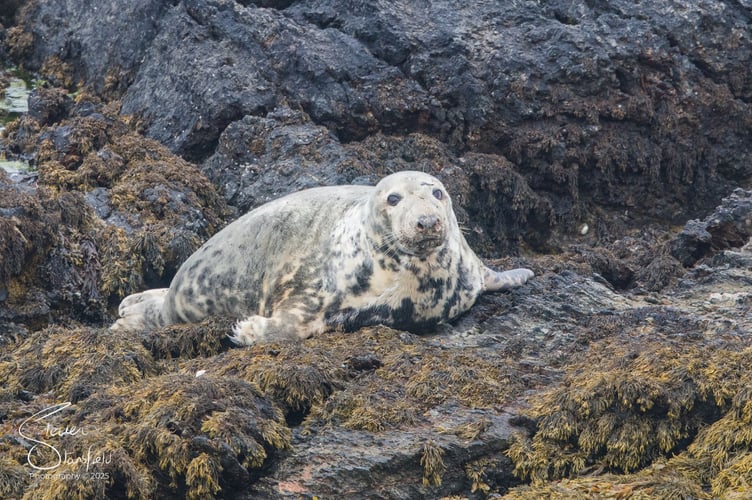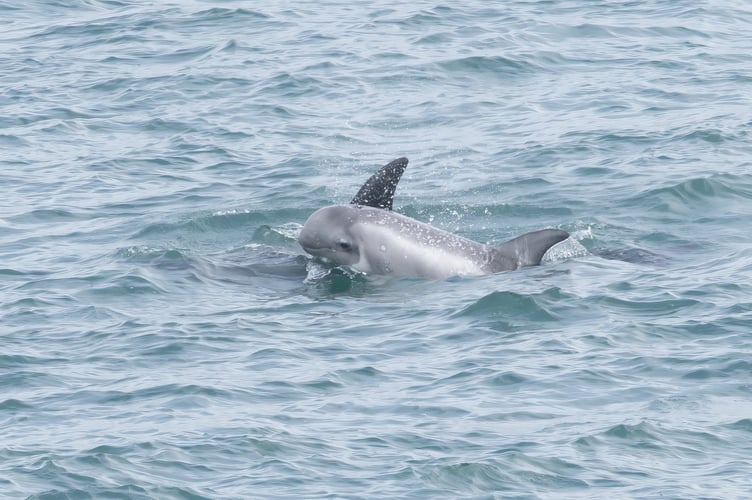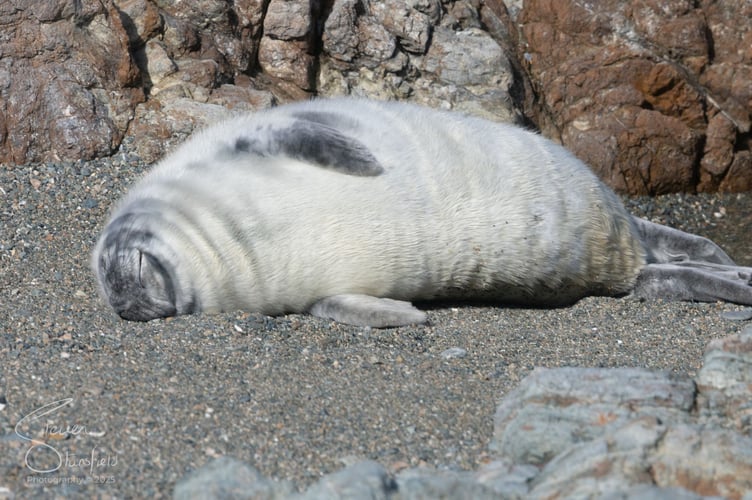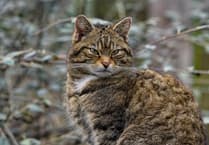A new study has revealed a worrying decline in the number of porpoises recorded off the Llŷn Peninsula.
The Bardsey Marine Mammal Project has revealed the importance of the waters around Ynys Enlli / Bardsey Island for the elusive Risso’s dolphin, with a large number of mothers with young calves spotted this year, but, sadly, there have been far fewer sightings of porpoises.
Phoebe Moss, Scientific Officer with The Bardsey Marine Mammal Project, has undertaken many hours of timed watches from the island over the Summers of 2024 and 2025 and says: “The presence of young calves with many of the Risso’s dolphins suggests these waters are important in their life cycles.”
Dolphin studies have routinely been undertaken on Bardsey for a number of years, but this is the first time that drones have been used on a regular basis to obtain photographs of the animals, enabling the identification of individual animals.
Previously boats were used to collect data and imagery, but vessels take time to launch, and the noise of their motors can disturb the dolphins, all limitations that the use of drones avoids.
The timed watches also recorded other species such as common and bottlenose dolphins and especially harbour porpoise.
The seas around Bardsey are designated as a Special Area of Conservation (SAC) for the porpoise.

It is therefore worrying that the study noted a decline of 97 per cent in the frequency of porpoise recorded, compared with studies from previous years.
Mick Green, project manager, said: “This is an especially worrying finding given that the waters are designated to protect porpoise.
“We will be developing work on the porpoise, and comparing our results with other studies, to better understand why they seem to be in decline, over the next field seasons.
“Over spring the project, working with our partners at Pen Llŷn a’r Sarnau SAC, has been recruiting volunteers on Pen Llŷn to undertake watches from the mainland and there are now regular watches from three sites around the area, increasing our coverage and adding to our knowledge of the distribution of our cetaceans.”
The Bardsey Marine Mammal Project is a new study based within the Bardsey Bird and Field Observatory (www.bbfo.org.uk and http://bbfo.blogspot.com/p/bardsey-marine-mammal-project.html).
The project is funded by the Nature Networks Programme and is being delivered by the Heritage Fund on behalf of the Welsh Government.
It has developed the use of drones to take photographs of dolphins that come in close to the island that can be used to individually identify dolphins from the unique marks on their dorsal fins.
Risso’s dolphin are a large dolphin with a worldwide distribution. However, they are generally found offshore in deeper waters and so are difficult to study.

Bardsey Island is one of the few places around the UK where there regularly come close to shore. Marine experts are yet to understand why, but it makes the island a unique place to study them and help to understand their conservation needs.
Seals are also an important part of life around Bardsey.
On 5 September, Ardak Cadwraeth Arbennig (ACA) had a great day on Bardsey with their Shorewatch volunteers as part of the Bardsey Marine Mammal Project.
An ACA spokesperson said: “A highlight was spending time with Phoebe Moss, the project’s Science Officer, learning all about her survey work and seeing some of the recently born seal pups.
“Phoebe and Bardsey Bird and Field Observatory staff and volunteers will be monitoring the seals over the coming months.”
The Shorewatch volunteers were thanked for “getting stuck in as their “surveys are invaluable in gathering information about the dolphins, porpoise and seals in our seas”.
New volunteers are always needed for the project to be able to continue the important monitoring work on and off Bardsey that has been going on since the early 1990s. This survery work helps to cover a wider area, and that has, in turn, led to the worrying news about the reduced number of porpoises.
Mick Green added: “We don’t think that the porpoises have moved elsewhere. We believe it’s a genuine decline in numbers. There’s been a decline in the Irish Sea too.
“It is thought that the Irish Sea population, which are the ones we see at Bardsey, have been caught in large fishing nets. Big trawlers trawl large areas of the sea, and if porpoises are trawling too, they can get caught in the nets and drown because they are air breathing.”
Mick, who is based in Talybont, helped set up the project in the 1990s, and has been involved on and off ever since. “This is the worst decline of porpoises we’ve seen,” he said.
“When I was up there setting up our new project I didn’t see any porpoise and I thought that was very strange, because you used to see them all the time, so we studied the area and crunched the numbers and this is a serious decline in an area where they are supposed to be protected, so what’s going on, why are they not being protected?
“It’s quite likely the threat is outside the protected area but we must still do somethng about it. We have a legal obligation to protect all cetaceans but I don’t see a lot happening.
“Obviously if the issue is in international waters, or Irish waters, it’s difficult, but I still think the Welsh Government should look at this as the decline is being felt in the protected area and there is a legal obligation.”
When asked why dolphin populations are not similarly affected, Mick said: “Risso dolphins are doing well and that’s because they tend to feed on octopus and squid which are found in much deeper waters. This means they are diving for food much deeper than the porpoises and, therefore, avoid the fishing nets.”
Mick added: “I think the Marine centre in New Quay have seen a decline in porpoise numbers too, so there seems to be reduced numbers in the middle of Cardigan Bay too, but Fishguard are seeing similar numbers so it seems to be steady there.”
Laura Hughes is the Marine Project Officer for the Pen Llyn and Sarnau Special Area of Conservation (SAC), supporting the group of volunteers they have recruited on the Llyn.
“Part of my role involves being the community officer for the Bardsey Marine Mammal Project,” Laura explained.
“I look after community engagement, organising and attending events and going into schools.
“We also recruit and train up volunteers for Shorewatch, and we’ve set up three Shorewatch sites on the Llyn.
“When they can, the volunteers go to these sites and do a 10 minute survey to gather data on a host of marine mammal species including dolphins, porpoises, whales and seals.”
Pen Llŷn a’r Sarnau Special Area of Conservation (SAC) is a marine protected area that begins near Nefyn, on the north coast of Llŷn and extends over 230km to about a mile north of Aberystwyth. It has been designated because of its wealth of incredible wildlife and habitats including bottlenose dolphins and grey seals.
Highly active, curious and acrobatic, bottlenose dolphins are often spotted in the waters around Abersoch. They’re the most widely recognised species of dolphin with their large bodies, short stubby beak and ‘smiling’ mouths.
UK bottlenose dolphins are the biggest in the world (their larger size helps them cope with our colder waters) and Cardigan Bay is one of only two areas around the UK hosting a semi-resident population.
They can live for up to 50 years reaching sexual maturity at about 12 and giving birth to a single calf between April and October.
Grey seals are among the rarest seals in the word with the UK population representing about 40 per cent of the world population.
Often spotted around Carreg y Trai (Half tide rocks) and Ynysoedd St Tudwal in Abersoch grey seals are one of the easiest marine mammals to spot because although they spend most of their time in the sea feeding on fish, they haul out on land to rest and digest their food.
One of the projects focusing on marine mammals within the SAC is Bardsey Marine Mammal Project, a partnership between Bardsey Bird and Field Observatory and Pen Llŷn a’r Sarnau SAC, with collaboration from North Wales Wildlife Trust and Whale and Dolphin Conservation.
It is funded by the Nature Networks Programme and is being delivered by the Heritage Fund on behalf of the Welsh Government.
Bardsey Island lies at the heart of a key area for marine mammals. The surrounding waters are regularly used by harbour porpoises, bottlenose dolphins, Risso’s Dolphins, common dolphins and Minke whales.
The aim of the project is to study the marine mammals in the area to provide clear information on their status, and to understand how and why they use these waters. This will inform conservation measures to better protect these important species.
Science officer Phoebe Moss spends the summer months on Bardsey, increasing systematic recording of marine mammals around the island and utilising drone technology.
“I monitor sea state, weather conditions, and any marine animals that cross my path while I wait for fins to appear!” she said.
“Once spotted, I record the coordinates, the number of individuals, and take some rough behavioural notes before deploying our drone.”
In 2024, 75 per cent of her cetacean sightings were Risso’s dolphins and we recorded calves and juveniles.
Phoebe is now analysing the images to identify individual dolphins from the unique patterns on their dorsal fins to understand more about this fascinating species.

Shorewatch is marine charity Whale and Dolphin Conservation’s (WDC) citizen science programme, with a dedicated network of Shorewatch volunteers out on the coast gathering data on cetaceans.
It was set up over 20 years ago by WDC and the 1000+ strong community of local Shorewatchers have now clocked up over 1 million minutes worth of data collection.
While WDC’s Shorewatch is currently most active in Scotland, exciting developments are underway - the Bardsey Marine Mammal Project is working with WDC to bring its Shorewatch programme to Wales.
As part of the drive to increase marine mammal recording around Llŷn the project is offering Shorewatch training and recruiting volunteers to carry out cetacean surveys from key sites including Bwlchtocyn, Uwchmynydd and Porthdinllaen.
WDC’s Shorewatch involves a a 10-minute whale, dolphin and porpoise survey carried out by volunteers at specific sites following a defined methodology. All volunteers attend an initial training session so that each 10-minute Shorewatch is carried out the same way and can be compared to other watches and sites. Over time marine experts hope to build up enough watches to reliably note when cetaceans are changing how they’re using the sites, and the data gathered will be used to influence policy and ensure better protections for these incredible marine mammals.
If you’re interested in marine mammals, have a passion for marine conservation or just love spending time on the coast and would like to offer your services as a volunteer, do get in touch.
And they will be organising several opportunities to learn more about marine mammals throughout the year so keep an eye out.
Volunteers and visitors to the coast should always follow the marine code.
Laura said: “Encountering a marine mammal is a mesmerising experience but when out on the water it’s always important to follow the North and West Wales Marine Code and remember the key points:
- Look out for wildlife – if you stop to watch, enjoy their company for a maximum of 10 minutes.
- Keep your distance – at least 100 metres away.
- Reduce speed and sound – within 300 metres proceed at ‘no wake’ speed and at no more than 5 knots.
More information can be found on the website, www.penllynarsarnau.co.uk/projects/bardsey-marine-mammals.
You can also email [email protected].
Alternatively, you can visit tiramor.cymru, or you can just search Plas SAC to find the relevant websites and links.




Comments
This article has no comments yet. Be the first to leave a comment.